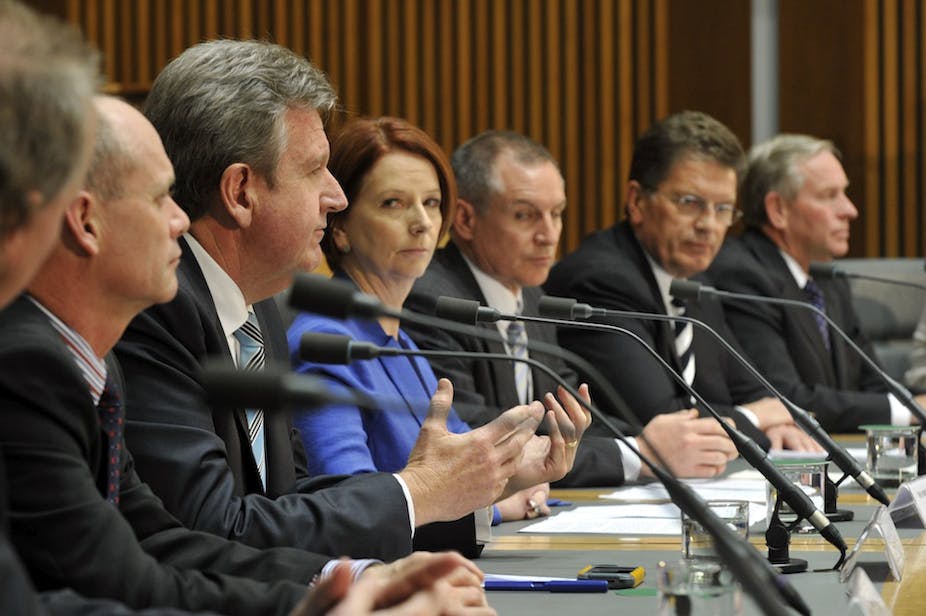As Prime Minister Julia Gillard prepares to meet with state premiers at Friday’s COAG meeting, the elephant in the room will be the Independent GST Review, released by Treasurer Wayne Swan last week.
The GST review has been a disappointment for a number of states, depending on whether they want to increase state-based mining royalties (such as Queensland and WA) or alter the proportion of GST revenue they receive (such as Victoria, and again WA).
Made up of former state premiers John Brumby and Nick Greiner with Ferrier Hodgson managing partner Bruce Carter, the GST review covered a wide range of public finance issues that went well beyond those relating to the efficiency and equity of the tax itself.
The panel were also requested to examine core issues relating to Horizontal, Fiscal Equalisation (HFE) and the implications of taxes where Commonwealth and State taxes interact, such as in the current tax environment faced by some miners.
To burden the Review with such wide-ranging aims may not have been wise. There are enough issues relating to the GST, particularly the ability of the GST in its current form to fund further reductions in state taxes, to have kept it fully occupied - such as the coverage (incidence) of the tax and its rate.
As the Review noted the growth in GST revenue grew strongly up until 2007-08 (over 8%) but has since fallen significantly to average 6% over the whole period of its introduction.
Consequently, the GST revenue pool has been “highly volatile, contributing to the difficulties faced by States in managing their fiscal positions”. When the GST (in its several guises) was first proposed it was seen as providing both equity and efficiency measures.
Reducing the growth in the informal (cash) economy was also seen as an advantage. Unfortunately this does not seem to be the experience worldwide. A 2012 survey of indirect taxes by Ernst & Young concluded “the increasing importance of indirect taxes exposes them to greater risk of fraud and tax avoidance”.
The Review, taken up as they were with issues of HFE, said nothing about this issue except to suggest “ensuring the GST pool is robust and stable” – really!
From its inception the GST in Australia has been constrained by two factors: its incomplete coverage and the fixed nature of its rate. Simplicity and transparency should be the key element of all taxes.
By exempting some items from the GST, most noticeably food items, health and education, the tax does not pick up some of the fastest growing areas of consumer spending and these exemptions almost certainly led to the initial tax being introduced at a higher rate. The Review Committee has little to say on these issues.
Paradoxically it does hit at another area of consumer spending; on-line purchasing. It wants to bring purchases above $500 into the GST net and in so doing reduce one of the few factors producing real competition in the Australian retail market.
This week though, the federal government ruled out lowering the threshold, to a chorus of disapproval from business groups and prominent retailers such as Solomon Lew.
Overall, as a document to reform the GST - its original purpose - the Review is disappointing; but it has more in-depth analysis on HFE matters and the role of state taxes such as royalties on the Mining Resources Rent Tax (MRRT).
The HFE scheme aims to provide an approximately equal standard of government service provision across all States and territories.
There is of course a potential moral hazard to doing this, as it may encourage some inefficiency in less well endowed states and reduce the incentive for wealthier states to introduce efficiencies in the knowledge that any benefits they achieve may be dissipated in reduced revenue sharing by the Commonwealth.
The European experience of using a common currency system has shown the inherent dangers in trying to ensure equality among the unequal; but there is no “Greece” or “Spain” among the Australian states, and while Western Australia might like to pretend it is “Germany” in the current climate, the Review correctly pointed out that Western Australia has, historically, been a net beneficiary of the system and will be again as the mineral boom subsides.
So the Review concluded that the current HFE, by and large, did what it was supposed to do and they couldn’t really come up with a better system.
The MRRT issue also gained prominence. This is a tax much beloved by economists and is often described as an “elegant tax”. The problem is such taxes are profit based and often don’t raise revenue. By contrast, output based taxes such as royalties are seen as inefficient and, being state based, do not contribute to the general commonwealth revenue.
The Review was quite clear; state-based taxes such as royalties should not be allowed to interfere with the MMRT. Rather state royalties on iron ore, coal and petroleum should be reduced by one third. The problem is that these moves would make state revenues even more open to fluctuation.
Artificial manipulation of profits through transfer pricing and cost allocation will make MRRT an unpredictable generator of revenue. Profits can be hidden but it’s fairly hard to hide a ton of coal. Royalties for all their inherent problems in inhibiting production may prove a more dependable means of raising revenue.
In short, the Review accepted the mantra of the Government, HFE, MMRT are good, royalties and state taxes are bad. It might have been better concentrating on getting the coverage and the level of the GST right before considering these broader issues.

